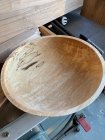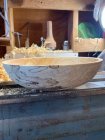I've searched around but have not found the right combination of words to get results for this query.
This week, I cut down a standing dead tree - not sure what it is, some sort of New England hardwood. The first inch under the bark is punky, and the next inch or so has quite a nice spalting effect.
I turned a bowl, well started to. Started with a faceplate on the flat face on the pith side, and turned round with a center. Got down through the punky wood, and into the spalted wood. Added a dovetail recess 1/4" deep for the chuck, and swapped ends.
Long story short, it quickly broke off at the chuck. From reading, I merely snugged it up, and also ensured the jaws were at a 45 to the grain to make sure each was acting on the same wood. The recess had more than an inch of wood outside it.
My plan as of now is to put it back on the faceplate, and turn it down another 1/2" or so, making it shallower. At that point I'm hoping to be in more solid wood for a recess. Would it be better to turn it down 7/8" or so and make a tenon on that end? This wood is quite green, and this will be a twice turned bowl, or at least that is current plan.
What is the right way to approach chucking softer wood? Can a sacrificial plate be glued to green wood? Is it simply use the tailstock as long as possible when hollowing? All this said, I'm sure that sharp tool and light touches will also be necessary.
This week, I cut down a standing dead tree - not sure what it is, some sort of New England hardwood. The first inch under the bark is punky, and the next inch or so has quite a nice spalting effect.
I turned a bowl, well started to. Started with a faceplate on the flat face on the pith side, and turned round with a center. Got down through the punky wood, and into the spalted wood. Added a dovetail recess 1/4" deep for the chuck, and swapped ends.
Long story short, it quickly broke off at the chuck. From reading, I merely snugged it up, and also ensured the jaws were at a 45 to the grain to make sure each was acting on the same wood. The recess had more than an inch of wood outside it.
My plan as of now is to put it back on the faceplate, and turn it down another 1/2" or so, making it shallower. At that point I'm hoping to be in more solid wood for a recess. Would it be better to turn it down 7/8" or so and make a tenon on that end? This wood is quite green, and this will be a twice turned bowl, or at least that is current plan.
What is the right way to approach chucking softer wood? Can a sacrificial plate be glued to green wood? Is it simply use the tailstock as long as possible when hollowing? All this said, I'm sure that sharp tool and light touches will also be necessary.


